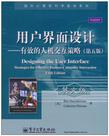用户界面设计
出版时间:2010-11 出版社:电子工业出版社 作者:(美)施奈德曼,(美)普莱萨特 著 页数:601
Tag标签:无
前言
Designing the User Interface is written for students, researchers, designers, managers, and evaluators of interactive systems. It presents a broad survey of how to develop high-quality user interfaces for interactive systems. Readers with backgrounds in computer science, psychology, sociology, industrial engineering, information science/studies/systems, business, education, and communications should all find fresh and valuable material. Our goals are to encourage greater attention to usability issues and to promote further scientific study of human-computer interaction, including the rapidly emerging topic of social media participation. Since the publication of the first four editions of this book in 1986, 1992, 1998, and 2005, HCI practitioners and researchers have grown more numerous and influential. The quality of interfaces has improved greatly, while the community of users and its diversity have grown dramatically. Researchers and designers could claim success, but today user expectations are higher, applications are more demanding, and platforms are more varied. In addition to desktop computers, designers now must accommodate web-based services and an increasingly diverse set of mobile devices. User interface designers are moving in new directions: some innovators provoke us with virtual and augmented realities, whereas others offer alluring scenarios for ubiquitous computing, embedded devices, and tangible user interfaces. These innovations are important, but much work remains to be done to improve the experiences of novice and expert users who still struggle with too many frustrations. These problems must be resolved if we are to achieve the goal of universal usability, enabling all citizens in every country to enjoy the benefits of these new technologies. This book is meant to inspire students, guide designers, and provoke researchers to seek those solutions.
内容概要
本书为了适应因特网和各种移动设备迅猛发展的形势,在第四版的基础上始终以基于Web、桌面和移动设备的设计作为内容主线。新的设计实例涉及电子商务、在线社区、电子政府、图片管理、购物、交通、游戏和移动电话,选材新颖实用,切合目前的应用实际。同时,新版本扩展了社会媒体参与和用户生成内容的介绍,代表了人机交互著作的主流发展趋势。 本书面向的读者极为广泛,具有计算机科学、心理学、社会学、工业工程学、信息科学、信息研究、信息系统、商业、教育和通信知识背景的读者,都可以在本书中发现新鲜的、有价值的信息。
作者简介
作者:(美国)施奈德曼(Ben Shneiderman) (美国)普莱萨特(Catherine Plaisant)
书籍目录
PART 1 INTRODUCTION CHAPTER 1 Usability of Interactive Systems CHAPTER 2 Guidelines, Principles, andTheoriesPART 2 DEVELOPMENT PROCESSES CHAPTER 3 Managing Design Processes CHAPTER 4 Evaluating Interface DesignsPART 3 INTERACTION STYLES CHAPTER 5 Direct Manipulation andVirtual Environments CHAPTER 6 Menu Selection, Form Fill-in, and Dialog Boxes CHAPTER 7 Command and Natural Languages CHAPTER 8 Interaction Devices CHAPTER 9 Collaboration and Social Media ParticipationPART 4 DESIGN ISSUES CHAPTER 10 Quality of Service CHAPTER 11 Balancing Function and Fashion CHAPTER 12 User Documentation and Online Help CHAPTER 13 Information Search CHAPTER 14 Information VisualizationAfterword Societal and Individual Impact of User Interfaces Name index Subject index Acknowledgments About the Authors
章节摘录
插图:Acknowledgments Writing is a lonely process; revising is a social one. We are grateful to the many colleagues and students who have made suggestions for improvements to prior editions. We particularly appreciate the strong contributions from Maxine S. Cohen to Chapters 4, 5, 9, and 12 and Steven M. Jacobs to Chapters 3, 7, 10, and 11, as well as their help throughout the book. Their experiences both in industry and in teaching with the earlier editions of the book over the course of many years added valuable perspectives to this fifth edition. After one two-day kickoff meeting, we collaborated smoothly by using e-mail, LiveSync for draft documents, and Skype for hour-long phone calls every one to three weeks. Cooperative personalities, hard work, and appropriate tools made this massive project possible even with tight time constraints. We look forward to a continuing partnership on the Companion Website and future editions. Our close daily collaborators at the University of Maryland have a profound influence on our work: many thanks to Ben Bederson, Allison Druin, Fran.ois Guimbretière, Kent Norman, Doug Oard, Jennifer Preece, Anne Rose, and Vibha Sazawal. We also appreciate the undergraduate and graduate students who provide encouraging feedback and challenging questions, plus the motivation to keep updating this book. Extensive comments from the review panel played a strong role in our revisions. These individuals made numerous constructive suggestions: Harry Hochheiser, Towson University Juan Pablo Hourcade, University of Iowa Richard D. Manning, Nova Southeastern University Chris North, Virginia Tech Jeff Offutt, George Mason University
编辑推荐
《用户界面设计:有效的人机交互策略(第5版)(英文版)》:国外计算机科学教材系列
图书封面
图书标签Tags
无
评论、评分、阅读与下载
用户评论 (总计4条)
- 值得购买,写的很有深度,也易懂
- 两个都买了,国内关于交互的书不是太多。。。。但是中文翻译的没有英文的好,主要看英文的,中文的辅助哈~~~
- 国内这方面的教材很少,国外的这本还算是好点了的,但是读起来也感觉一般般~
- 无论是包装,还是印刷,都不错呢。。。。给个好评
相关图书
- 特征提取与图像处理
- 人脸图像信息处理与识别技术
- 网络信息安全项目教程
- 探地雷达原理与应用
- 包装设计
- PASW/SPSS Statistics中文版统计分析教程
- Visual Basic 2008大学教程
- C++大学教程
- Mastercam X3数控加工行业应用实践
- UG NX6.0模具设计行业应用实践
- 模具CAD/CAM应用
- 高速数字系统的信号完整性和辐射发射
- Windows Phone 3G手机软件开发
- UG NX 7.0产品设计行业应用实践
- AutoCAD2011中文版机械制图快速入门实例教程
- 计算机图形学
- AutoCAD2011中文版室内装潢设计制图快速入门实例教程
- 多媒体技术与应用基础
- 计算机应用基础
- Maya基础训练教程
- UG NX CAD应用案例教程
- 这样拍才更好
- 化工单元操作实训
- 理论力学辅导与训练
- 湖北省第四次卫生服务调查报告
